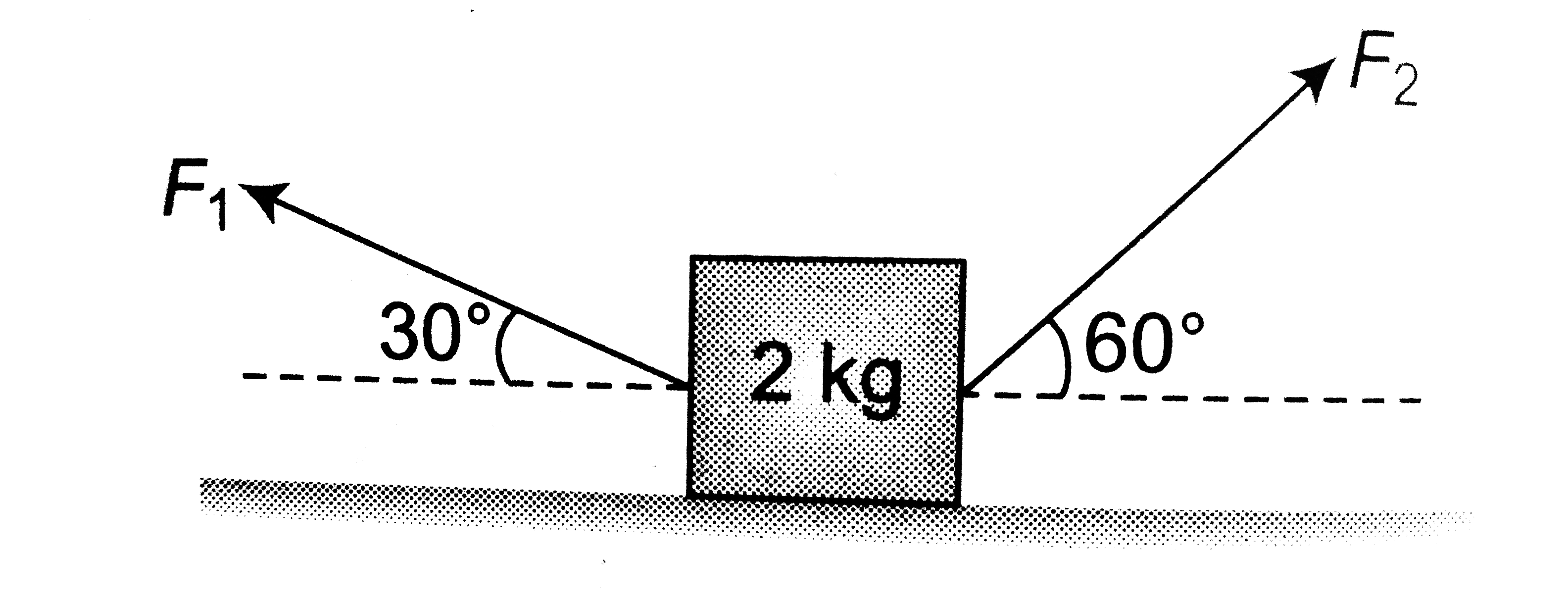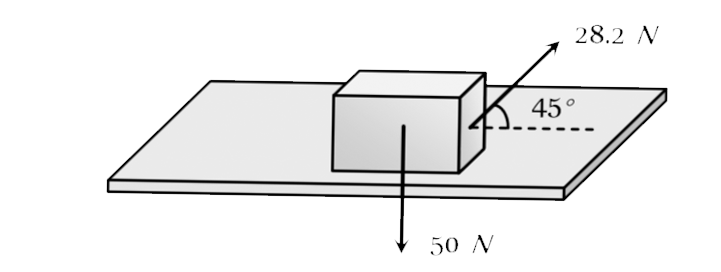A body of mass 2.0kg is placed on a smooth horizontal surface. Two force F1=20N and F2=N are acting on the body in directions making angles of 30∘ and 60∘ to the surface. The reaction of the surface om the body will be

20N
25N
5N
zero
The correct Answer is:D
Let us find vertical force:
F1sin30∘+F2sin60∘
=20×12+10√3(√32)=25N
This is greater than mg. So contact of body with surface will be lost and reaction will be zero.
Topper's Solved these Questions
- BOOK - A2ZCHAPTER - NEWTONS LAWS OF MOTIONEXERCISE - Applications Of Newton'S Laws Of Motion33videos
NEWTONS LAWS OF MOTION
- BOOK - A2ZCHAPTER - NEWTONS LAWS OF MOTIONEXERCISE - Basic Concept Of Static And Kinetic Frictions45videos
NEWTONS LAWS OF MOTION
- BOOK - A2ZCHAPTER - NEWTONS LAWS OF MOTIONEXERCISE - Linear Momentum And Impulse20videos
NEWTONS LAWS OF MOTION
- BOOK - A2ZCHAPTER - MOTION IN TWO DIMENSIONEXERCISE - Chapter Test29videos
MOTION IN TWO DIMENSION
- BOOK - A2ZCHAPTER - OSCILLATION AND SIMPLE HARMONIC MOTIONEXERCISE - Chapter Test29videos
OSCILLATION AND SIMPLE HARMONIC MOTION
Similar Questions
A block of mass 2 kg is plased on a smooth horizontal surface. Two forces F1=20 N and F2=5 N start acting on the block in opposite directions as shown. If block gets displaced by 5 m in the direction of net force then work done by F2 is :-
 View Solution
View Solution
A body of weight 50 N placed on a horizontal surface is just moved by a force of 28.2 N. the frictional force and the narmal reaction areView Solution
Knowledge Check
- Question 1 - Select One or More
A body of mass 10 kg is acted upon by two perpendicular forces , 6 N and 8 N . The resultant acceleration of the body is
A1ms−2 at an angle of tan−1(34) w.r.t. 6 N forceB0.2ms−2 at an angle of tan−1(43) w.r.t. 6 N forceC1ms−2 at an angle of tan−1(34) w.r.t. 8 N forceD0.2 ms−2 at an angle of tan−1(34) w.r.t. 8 N force - Question 2 - Select One
A body of mass 2 kg is placed on a horizontal surface having coefficient of kinetic friction 0.4 and limiting coefficient of static friction 0.5. If a horizontal force 2.5 N is applied on the body, the frictional force acting on the body will be (Take, g=10ms2)
A8 NB10 NC20 ND2.5 N - Question 3 - Select One
A body of mass 10 kg is moving on a horizonal surface be applying a force of 10 N in the forward direction. The body moves with a constant velocity of 0.2ms−1. Work done by the force of friction in the first 10 seconds is
A−20JB10 JC20 JD−5J
A force acts for 8 s on a body of mass 5kg at rest,on a smooth horizontal surface.The force then stops acting and the body describes 80m in next 5s .The force acting on body is ?
View SolutionA force acts for 8 s on a body of mass 5 kg at rest,on a smooth horizontal surface.The force then stops acting and the body describes 80 m in next 5 s .The force acting on body is
View SolutionA block of mass 5 kg is resting on a smooth surface at what angle a force of 20 N be acted on the body so that it will acquire a kinetic energy of 40 J after moving 4 m?
View SolutionA block of mass 5 kg is resting on a smooth surface. At what angle a force of 20 N be acted on the body so that it will acquired a kinetic energy of 40 J after moving 4 m?
View SolutionThe block of mass 4kg is placed on a rough horizontal surface having the coefficient of kinetic and static friction as 0.4 and 0.5 respectively. If a force of 4N is applied to the body, then the frictional force acting on the body will be [g=ms2]
View Solution

